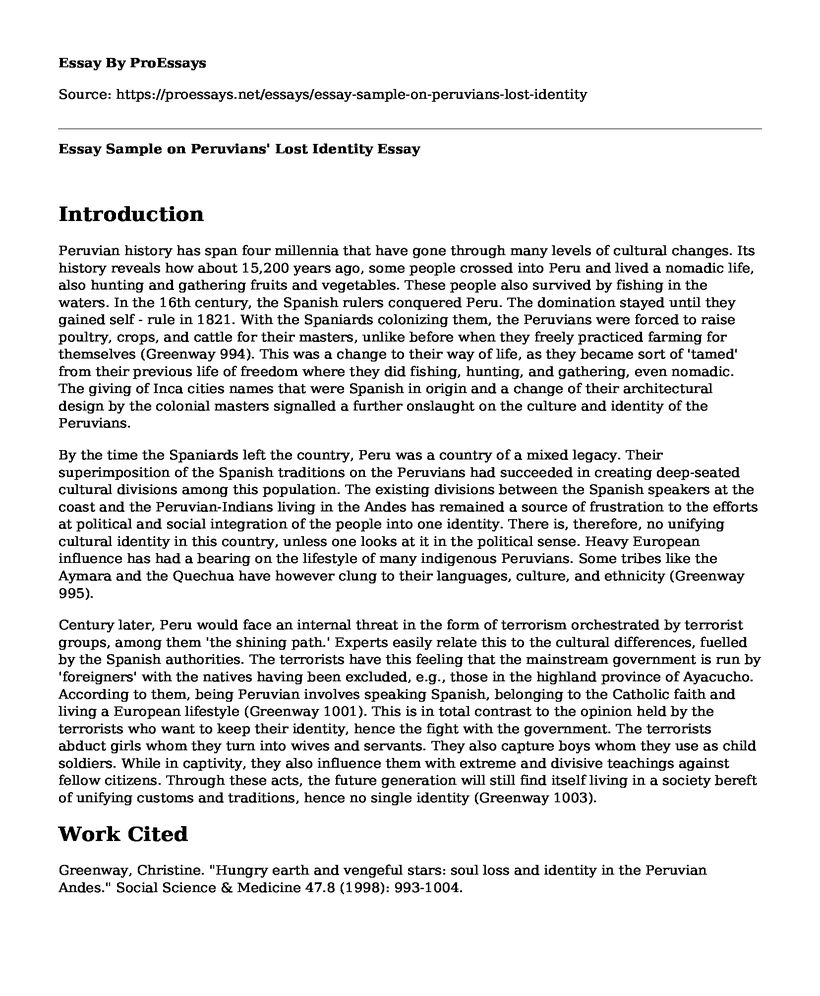Introduction
Peruvian history has span four millennia that have gone through many levels of cultural changes. Its history reveals how about 15,200 years ago, some people crossed into Peru and lived a nomadic life, also hunting and gathering fruits and vegetables. These people also survived by fishing in the waters. In the 16th century, the Spanish rulers conquered Peru. The domination stayed until they gained self - rule in 1821. With the Spaniards colonizing them, the Peruvians were forced to raise poultry, crops, and cattle for their masters, unlike before when they freely practiced farming for themselves (Greenway 994). This was a change to their way of life, as they became sort of 'tamed' from their previous life of freedom where they did fishing, hunting, and gathering, even nomadic. The giving of Inca cities names that were Spanish in origin and a change of their architectural design by the colonial masters signalled a further onslaught on the culture and identity of the Peruvians.
By the time the Spaniards left the country, Peru was a country of a mixed legacy. Their superimposition of the Spanish traditions on the Peruvians had succeeded in creating deep-seated cultural divisions among this population. The existing divisions between the Spanish speakers at the coast and the Peruvian-Indians living in the Andes has remained a source of frustration to the efforts at political and social integration of the people into one identity. There is, therefore, no unifying cultural identity in this country, unless one looks at it in the political sense. Heavy European influence has had a bearing on the lifestyle of many indigenous Peruvians. Some tribes like the Aymara and the Quechua have however clung to their languages, culture, and ethnicity (Greenway 995).
Century later, Peru would face an internal threat in the form of terrorism orchestrated by terrorist groups, among them 'the shining path.' Experts easily relate this to the cultural differences, fuelled by the Spanish authorities. The terrorists have this feeling that the mainstream government is run by 'foreigners' with the natives having been excluded, e.g., those in the highland province of Ayacucho. According to them, being Peruvian involves speaking Spanish, belonging to the Catholic faith and living a European lifestyle (Greenway 1001). This is in total contrast to the opinion held by the terrorists who want to keep their identity, hence the fight with the government. The terrorists abduct girls whom they turn into wives and servants. They also capture boys whom they use as child soldiers. While in captivity, they also influence them with extreme and divisive teachings against fellow citizens. Through these acts, the future generation will still find itself living in a society bereft of unifying customs and traditions, hence no single identity (Greenway 1003).
Work Cited
Greenway, Christine. "Hungry earth and vengeful stars: soul loss and identity in the Peruvian Andes." Social Science & Medicine 47.8 (1998): 993-1004.
Cite this page
Essay Sample on Peruvians' Lost Identity. (2022, Mar 27). Retrieved from https://proessays.net/essays/essay-sample-on-peruvians-lost-identity
If you are the original author of this essay and no longer wish to have it published on the ProEssays website, please click below to request its removal:
- Collections of the Palace Museum
- Article Analysis: The Creation of Entrepreneurship Opportunities for People Who Are at the Base of the Economic Pyramid
- The Pop Culture and Futurama Essay
- Project Title: Organizing a Networking Biometric Technology Event
- Essay Example on Social Construction: Understanding Meaning in Society
- Paper Example on Michael Ondaatje: Journey Through Mixed Cultures
- Essay Sample on Marco's Father Making Decisions: Dilemma for Marco







